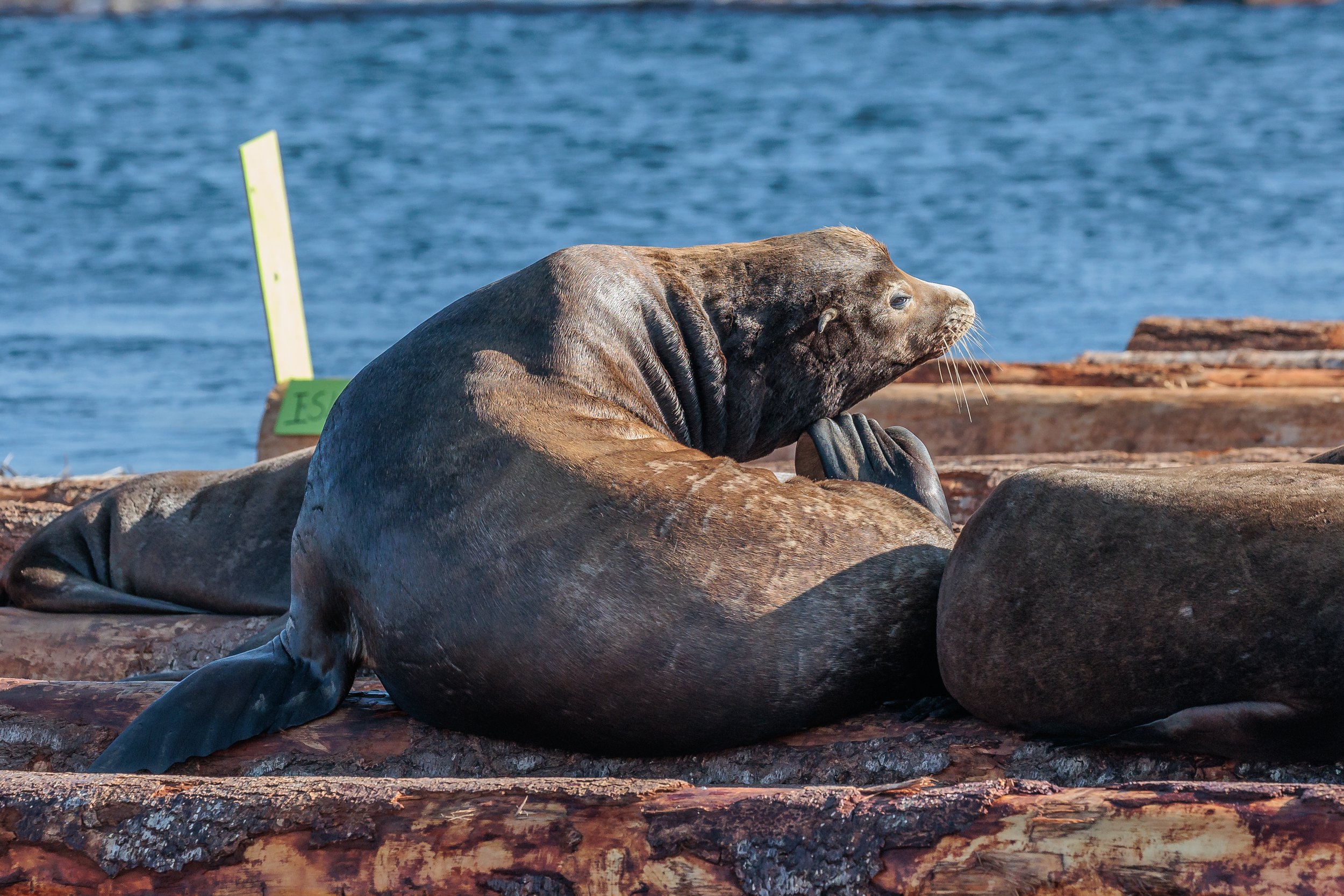September 29, 2023 - The T049As and T036As together, T019C by himself and Honu the humpback
Our today started out with a report of Orca North of Nanaimo, close to Nanoose Bay. We headed that way and were greeted by the large number of dorsal fins, a good sign of a T-party! This time it was two pods travelling together: The T036As and the T049As!
T049A Nan ♀ (1986)
T049A1 Noah ♂ (2001)
T049A3 Nat ♂ (2011)
T049A4 Neptune ♂ (2014)
T049A5 Nebula ♀ (2017)
T049A6 (2022)
T036A Leland ♀ (1990)
T036A1 Tierna ♀ (2005)
T036A1A (2022)
T036A2 Kailas ♀ (2012)
T036A3 Mike II ♂ (2015)
T036A5 (2021)
These whales seemed to be on a mission, as they were travelling very quickly south in the Strait of Georgia.
Being incredibly fast and agile swimmers it’s always great to see the whales in action. Their speed can vary depending on the context, but they are known to reach impressive speeds in certain situations. Orcas typically swim at a cruising speed of around 3 to 4 miles per hour. This speed allows them to cover large distances efficiently when they are travelling. When hunting, orcas can accelerate to much higher speeds. They are capable of reaching speeds up to 34.5 miles per hour in short bursts, especially when chasing prey. Orcas are also known for their ability to ride the bow waves and wakes created by boats. When surfing these waves, they can reach speeds comparable to their bursts of speed, sometimes exceeding 30 miles per hour.
Orcas' speed and agility are essential for their hunting strategies. Their ability to swim quickly and work together in coordinated hunting efforts makes them highly effective hunters in the ocean. Today this T-party was heading North, using a faster-than-normal cruising speed to quickly travel through the water. If only we knew where they were headed!
While watching this speedy orca, we spotted a humpback whale in the distance, so once our hour with the orca was up, we decided to see if we would be able to find them. We followed the blows and soon arrived with our humpback! This whale was a little bit sleepy, but showed us enough of their identifiable features for us to figure out it was Honu (BCX1856). Honu was travelling solo today, and resting at the surface. Whales can still appear active, even while they are sound asleep! Usually after a few minutes of observation, our Naturalists can tell the animal may be sleeping. To avoid drowning, whales only sleep with one-half of their brains at a time, a process called uni-hemispheric sleeping. By remaining half awake and half asleep, the animal can continue to travel slowly, and more importantly, come up for shallow breaths while resting just below the surface. We usually don’t get many flukes when they are asleep (sometimes none), so we were happy to get at least one from Honu! As to not disturb them too much, we didn’t spend much time here before moving on. While with Honu, we got some shore-based reports of a different group of orca who had passed southbound through Dodd Narrows. This Narrow passageway is a great place for shore based whale watching since it filters the animals very close to shore. We headed that way to find the reported whales, but were instead greeted by only one individual. It was Spouter travelling by himself!
T019C Spouter ♂ (2001)
Spouter is usually found travelling with his Grandmother, but today she was off with the other two members of the pod, about a mile away as reported by some other whale-watching boats. Since our time was running short, we decided it was better to start to look for other wildlife on the way back to the dock instead of searching for the rest of the family.
We ended up seeing some Harbour Seals and Sea Lions on the way home, rounding out this double whale species day very nicely. The onboard Naturalists Des Poier, Cheyenne Brewster and Vanessa Vereschahen, captured some great photos of these encounters which you can enjoy below!
Honu fluking as they dive. Photo by Des Poier.
Photo by Des Poier.
T049A6 popping up behind their mother T049A Nan. Photo by Cheyenne Brewster.
Photo by Cheyenne Brewster.
T049A5 Nebula with her sibling T049A6 charging ahead! Photo by Cheyenne Brewster.
T036A1 Tierna with another following close behind. Photo by Cheyenne Brewster.
T049A Nan. Photo by Des Poier.
T049A Nan in the front, T049A5 Nebula following close behind and T049A4 Neptune coming up beside them. Photo by Des Poier.
Photo by Des Poier.
Splashing around! Photo by Des Poier.
Charging through the waves! Photo by Des Poier.
Photo by Des Poier.
Little T049A6 was just as rambunctious as ever! Photo by Des Poier.
Photo by Des Poier.
T049A1 Noah. Photo by Des Poier.
T049A3 Nat surfacing in front of his big brother T049A1 Noah. Photo by Des Poier.
Another great shot of T049A3 Nat. That dorsal is starting to straighten up a bit! Photo by Des Poier.
Photo by Des Poier.
Family photo! Photo by Des Poier.
T036A2 Kailas. Notice the tip of her dorsal? We use this feature to identify her. Photo by Vanessa Vereschahen.
T036A1 Tierna infront of another. Photo by Vanessa Vereschahen.
T019C Spouter. Photo by Des Poier.
T019C Spouter with his impressive dorsal fin! Photo by Des Poier.
Harbour Seals hauled out on the rocks. Photo by Cheyenne Brewster.
A California Sea Lion enjoying the sun. Photo by Des Poier.
Did you know Sea Lions have claws? This California Sea Lion is giving himself a scratch. Photo by Des Poier.
Someone does not look impressed. Photo by Des Poier.
Photo by Des Poier.
Look how beautiful these two posed for the camera! Photo by Des Poier.
Look at those teeth, this California Sea Lion is mad about something! Photo by Des Poier.
A very fuzzy Stellar Sea Lion napping. Photo by Des Poier.































